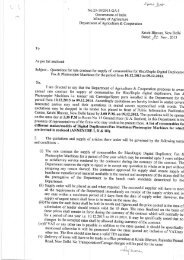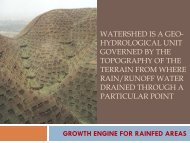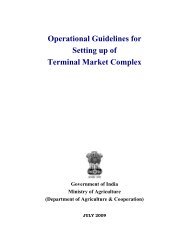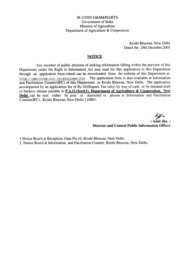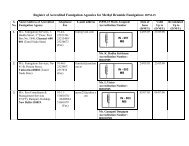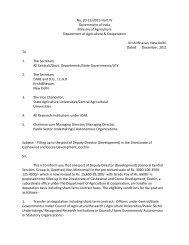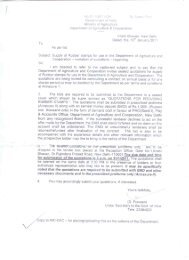Compendium on Soil Health - Department of Agriculture & Co ...
Compendium on Soil Health - Department of Agriculture & Co ...
Compendium on Soil Health - Department of Agriculture & Co ...
You also want an ePaper? Increase the reach of your titles
YUMPU automatically turns print PDFs into web optimized ePapers that Google loves.
Fertilizer c<strong>on</strong>sumpti<strong>on</strong> has to be crop resp<strong>on</strong>sive and efficient to increase producti<strong>on</strong> while<br />
rati<strong>on</strong>alizing input cost and minimizing envir<strong>on</strong>mental degradati<strong>on</strong>. A fertilizer not suitable to a<br />
soil type can be called as an incorrect fertilizer used for that soil and it will c<strong>on</strong>tribute in<br />
c<strong>on</strong>sumpti<strong>on</strong> amounts. Different types <strong>of</strong> fertilizers are required to be used in acid and alkali<br />
soils. Where citrate soluble and water insoluble phosphatic fertilizers can be efficiently used in<br />
acid soils, they will not resp<strong>on</strong>d in alkali soils. Fertigati<strong>on</strong> involving the use <strong>of</strong> water soluble<br />
fertilizers through sprinklers and drips is expected to give better use efficiency for both, the<br />
water and fertilizers. Site specific nutrient management involving soil test based applicati<strong>on</strong> <strong>of</strong><br />
fertilizers is critical to efficient utilizati<strong>on</strong>. Use <strong>of</strong> required sources <strong>of</strong> plant nutrients has to be<br />
promoted, coupled with the use <strong>of</strong> soil amendments in acidic/ alkaline soils for moderating<br />
acidity/alkalinity by bringing the soil pH to near neutrality so as to enhance soil nutrient<br />
availability and efficiency.<br />
The soil testing programme was started in India during the year 1955-56 with the setting-up <strong>of</strong><br />
16 soil testing laboratories under the Indo-US Operati<strong>on</strong>al Agreement for “Determinati<strong>on</strong> <strong>of</strong><br />
<strong>Soil</strong> Fertility and Fertilizer Use”. In 1965, five <strong>of</strong> the existing laboratories were strengthened and<br />
nine new laboratories were established with a view to serve the Intensive Agricultural District<br />
Programme (IADP) in selected districts. To meet the increasing requirement <strong>of</strong> soil testing<br />
facilities, 25 new soil-testing laboratories were added in 1970. In additi<strong>on</strong> to this, 34 mobile soil<br />
testing vans were established under the joint auspices <strong>of</strong> the Technical <strong>Co</strong>operati<strong>on</strong> Missi<strong>on</strong><br />
(TCM) <strong>of</strong> USA, IARI and Govt. <strong>of</strong> India to serve the farmers in remote areas and also provide<br />
educati<strong>on</strong> to them <strong>on</strong> the benefits <strong>of</strong> balanced fertilizati<strong>on</strong> through group discussi<strong>on</strong>s,<br />
dem<strong>on</strong>strati<strong>on</strong>s, film shows etc.<br />
The capacity <strong>of</strong> the soil testing laboratories in the intensive agricultural districts was initially<br />
created to analyse 30,000 soil samples annually by each laboratory. The installed capacity <strong>of</strong><br />
the laboratories varied from 1000 samples/yr/lab (some cases in UP) to 30,000 to 70,000<br />
samples/year, in Tamil Nadu. Out <strong>of</strong> 354 testing laboratories functi<strong>on</strong>ing with an analysing<br />
capacity at approx. 4 milli<strong>on</strong> soil samples per year, during 1981, 90 laboratories each had less<br />
than 5000 sample analysing capacity per annum, 142 labs had 6-10,000 samples capacity and<br />
65 labs had a capacity to analyze between 11-20,000 samples/year. A total <strong>of</strong> 47 labs had a<br />
capacity <strong>of</strong> 21-30,000 samples per year and 10 labs had more than 30,000 samples/year<br />
capacity. Presently, the thinking is to set-up smaller laboratories with the analysing capacity <strong>of</strong><br />
10-12,000 samples/year. Till about 1980, the laboratories generally used to analyse soil samples<br />
for pH, texture, electrical c<strong>on</strong>ductivity, and available N P K. There used to be no analysis for<br />
micr<strong>on</strong>utrients. The process <strong>of</strong> setting up <strong>of</strong> soil testing laboratories has c<strong>on</strong>tinued, year after<br />
year, with the financial support from Government <strong>of</strong> India, State Governments and Fertilizer<br />
companies who are also setting-up the soil testing laboratories.<br />
Government <strong>of</strong> India is promoting integrated nutrient management (INM) balanced and<br />
judicious use <strong>of</strong> chemical fertilizers, bio-fertilizers and locally available organic manures like<br />
farmyard manure, compost, vermi compost and green manure based <strong>on</strong> soil testing to maintain<br />
soil health and productivity. Total nutrient c<strong>on</strong>tent varies from soil to soil depending up<strong>on</strong> the<br />
nature <strong>of</strong> parent material and other soil forming processes. Only the plant available form <strong>of</strong> the



